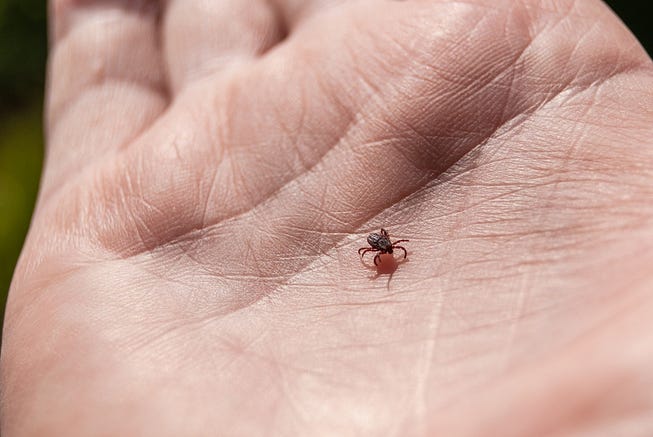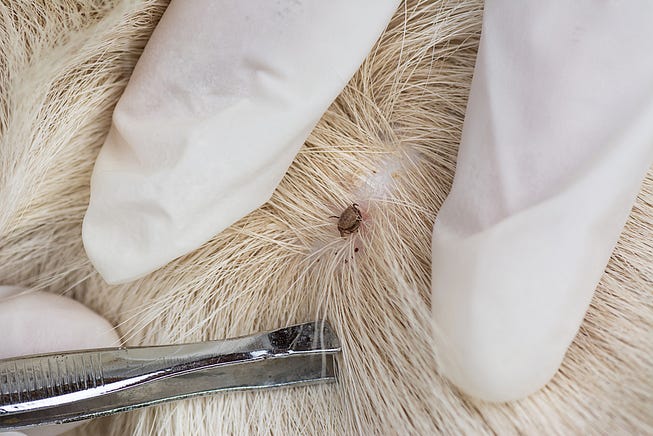Managing the Threat of Ticks While Enjoying the Great Outdoors
Jul 11, 2023
My husband came downstairs the other night to show me something he found on his dog, Jake. My husband is like that. He can’t just tell me. He has to show me. I think he likes to freak me out a little.
Well, he did.
Crawling in the palm of his hand was a live tick. Those gross little creatures we all fear, especially during the summer months. If you like to spend time outdoors or have family pets, you are probably familiar with them.

Most people think ticks are insects. They may be creepy, crawly, but they are actually arachnids, related distantly to spiders. They have eight tiny little legs and flat bodies.
They are very, very small so they are hard to detect.
Don’t be fooled by their diminutive size. Ticks can be dangerous, even deadly at times. They feed on the blood of wild animals, family pets, and people.
Once they attach themselves to the skin of their host, their tiny body fills with blood. In the process, they spread bacteria, viruses, and smaller parasites into the bloodstream.
Sounds like something from a horror movie.
Where they live
Unfortunately, ticks are found all over the United States and many other countries like the UK. They like wooded areas with plenty of trees, brush, tall grass, leaves, and where I live, sagebrush.
They also like places closer to your home. Birdfeeders, stacks of wood, piles of lawn debris, and even old furniture you’ve been planning on taking to the dump.
There are many different types of ticks. Each region of the United States seems to have its own “breed.”
And interestingly enough, the potential illness ticks can cause depends largely on what type of tick attaches itself to you.
For instance, the Colorado Tick Fever is caused by the Rocky Mountain wood tick. You are more likely to find this arachnid in the Rocky Mountains. For most people, the Colorado Tick Fever is a mild illness whose symptoms include headache, fever, and rash.
The Rocky Mountain spotted fever isn’t that common in the Rocky Mountains. You are more likely to pick up this disease by coming across an American dog tick, Rocky Mountain wood tick, or a brown dog tick somewhere in the southeast portion of the United States.
Lyme disease is the most well-known disease from ticks. It can be contracted from two different types of ticks; the black-legged ticks found in the upper midwest and northeast areas of the United States. On the west coast, the western black-legged tick is the culprit.
Those are just a few of the diseases and types of ticks found all around the United States. These creepy creatures are everywhere. And it’s not just a problem for hikers, hunters, campers, or fisherwomen like me.
Prevention by protection
Personal
Because ticks can be brought in by pets (like Jake), deer, raccoons, rodents, and birds, families living in the suburbs are just as at risk as ranch families in encountering ticks.
The best way to reduce your risk of getting attached to a tick is to start with prevention. When venturing out into tick-infested areas, wear long-sleeve shirts and long pants. Wear boots and tuck your pant legs into your boots.
If you prefer to wear sneaker-type shoes, tuck your pants into white or tan socks. Not only will this keep ticks from crawling up your leg, but ticks will also be more visible on light-colored socks.
When you return home, check yourself thoroughly for ticks crawling on your clothes or shoes. Don’t forget to look through your hat and hair as well.
Wash all your clothing in hot soapy water and dry on high heat.
Pets
To protect your pets, commercial sprays and medications are available. Medications can be purchased over the counter or from your veterinarian. Some are taken orally and some are placed on the skin at the back of the neck.
Sprays need to be rubbed into the skin, not just applied to the animal’s outer coat. And remember to wear gloves
Jake gets his medication on the back of his neck. It’s less work than giving him biweekly baths with flea and tick shampoo and easier than trying to cram a pill down his throat.
Medications and sprays work much more effectively than the typical flea and tick collar. They keep ticks away from the neck and face of your dog, but the rest of his body will be subject to tick attacks.
If you prefer a more natural way to protect your pet, try a homemade spray made with 1 part water to 2 parts vinegar (apple cider or white). Add 1 tablespoon vegetable oil for every cup of solution. Spray your pet well at least daily, more often if he tends to roam freely through the grass and brush.
Remember that tick spray and external medication needs to be reapplied on your pet every few weeks. Read the directions carefully and marked your calendar when due to apply again.
Alas, poor Jake was our reminder that he was overdue. Lesson learned.
Home and Yard
Around your home and yard, keep lawn debris to a minimum. Stack your firewood neatly and away from your house in a dry area if possible.
Mow your yard frequently and check your animal feeders for any tick infestation.
Do your best to keep wildlife out of your yard, a task that is easier said than done. People try all sorts of things from installing fencing to hanging dryer sheets in their shrubs. You may have to experiment to discover what works.
At least removing a bird’s nest is a little easier.
Flea and tick sprays are available to spray around your house and garden area. These sprays are different than what you apply to pets and probably a little more toxic.
Sprays can be used indoors as well. Use sparingly, but use if you must. Just be sure to read and follow instructions carefully.
If a tick gets attached
On people
After my husband did his “show and tell” with the tick, he flushed it down the toilet. It’s a good way to get rid of a live one crawling around.
Remember that ticks must bite you in order to transmit disease through your blood. If they are crawling around they obviously haven’t attached themselves yet.
But you do need to do a careful search to make sure there are no others.
Ticks love warm places so double-check the back of your knees, armpits, and hairline.
Oh, just check everywhere and then look again.
If you do discover an embedded tick, you need to remove it immediately and quickly. And not the way your father taught you to!
No lit match held near the tick. No covering it with Vaseline or nail polish.
The fastest and safest way to remove a tick is to use a pair of fine-tip tweezers, grasp the tick as close to your body as possible, and pull it straight out. Don’t twist or jerk as you pull. This could leave the head inside your skin.
Immediately clean the area with soap and hot water or rubbing alcohol. Flush the tick down the toilet or drown it in rubbing alcohol or bleach then wrap it in tape before disposing of it.
You can also put it in a small jar with a lid and take it down to your county extension office or similar agency for identification if you are concerned about what species of tick you played host to.
Symptoms of tick-borne illnesses can take up to thirty days or more to develop.
Symptoms to watch for include headache, fatigue, muscle and/or joint pain, rash, and fever.
If the tick was discovered and removed less than 36 hours after he met up with you, chances are you will be fine.
However, if any of these symptoms occur, see your doctor and let him know you were bitten by a tick.
On pets
The same steps would apply if you find a tick stuck on your dog. Remove the tick and clean the area carefully.
Symptoms of a tick-related illness will likely manifest in lethargy, limping and unusual walking pattern, and muscle tenderness.

A trip to the veterinarian will be in order if your pet shows any of these symptoms in the days or weeks following the removal of a tick.
Home Infestation
Inside your home, you can manage a tick infestation with sprays and deep cleaning with a solution of nine cups water to one cup bleach.
Wash pillows and bedding with hot soapy water and dry in high heat.
There is also something called diatomaceous earth (DE). It’s a non-toxic substance made from finely crushed fossils. Insects eat it and it tears up their insides (simple version of the story). It does not harm people or pets. In fact, it may be an ingredient in your facial cleanser.
Sprinkle the DE around the house, under the couch, near baseboards, and pet beds. Vacuum it up after a few days. Repeat if necessary which hopefully it won’t be.
Ticks can be a problem year-round, but summer seems to be the worst time of year for encountering the little pests.
Perhaps it’s the warmer weather that makes them more prevalent. Or the fact people are out partaking of nature.
Pets and wildlife are more active as well, carrying the parasites from location to location.
We don’t have to let our concerns about getting bitten by ticks stop us from enjoying the great outdoors. With the proper precautions, we can prevent and manage the threat of ticks.
Even if you live out in the boonies like me.
Feel a bit guilty for not taking better care of yourself?
Wish you had more time for it?
The Self-Care Mini-Workbook will help you discover what you are doing or could be doing to enhance your self-care practices? Give it a try for free!
Stay connected with our biweekly newsletter.
Join our mailing list to receive tips, tricks, product reviews, freebies and a little inspiration.
Don't worry, we know how busy you are. That's why we only share twice a month...unless it's really important news!
We hate SPAM. We will never sell your information for any reason.
